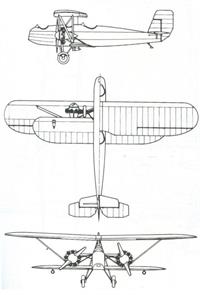The Heinkel HD-20 Observation Plane (From Aviation Week)
A German Twin-Engine Military or Commercial Machine with Whirlwind Engines.
Dr. Ing. Ernst Heinkel, of Germany, has earned an enviable reputation as a designer of planes which were somewhat out of the ordinary. His specialty has been simplicity of construction and ease of dismounting and assemblage. His latest product the I1D-20 fitted with two Wright Whirlwind engines and is designed for observation work. The twin-engine principle has many advantages for photographic work. It allows a degree of visibility forward and to the sides which cannot be obtained in a single-engine plane. Also, photographic planes are invariably used over cities or over extremely rugged mountainous country where a successful forced landing would be impossible. The low power loading and the comparatively low wing loading enable the plane to fly comparatively easily on one engine. The reserve power gives a high rate of climb and the ceiling of 16,400 ft., in the ease of the Heinkel HD-20 can be reached in .'55 min.
The plane is a biplane with a small lower wing and a large upper wing. The wings are heavily staggered and the gap is large. The wing tips are rounded but not tapered in thickness. The ailerons are in the upper wings only. The fuselage is of steel while the wings are of wood and fabric. The gasoline tanks are in the center of the upper wing which is slightly thickened at this point and which is also cut at the trailing edge to afford better visibility upward. An N type brace runs from the top of the fuselage to the lower wing at the point at which the engines are attached. From this point, a Vee strut runs to the two beams of the upper wing.
The landing gear is of the split-axle type. Jwo of the legs extending from the lower longerons of the fuselage and one from the upper longeron. The triangle formed is very narrow from the point of view of side shocks.
The two Wriuht Whirlwinds are very nicely streamlined into absolutely symmetrical power eggs from which only the heads of the cylinders protrude. The streamlining is completed with a large spinner on the propellers. The outer circle of the spinner is, however, of somewhat smaller diameter than the inner edge of the power egg so that a draft of air is able to reach the crankcase and the lower part of the cylinders of each engine. The power eggs contain the oil tanks and are demountable after removing the connections and undoing four bolts.
The plane has three seats in a row, the pilot occupying the center seat. The horizontal stabilizer is adjustable and the photographer can sit either in the very nose of the plane or to the rear of the pilot. The rudder is of large area and balanced and the vertical fin itself is adjustable so that the plane is easily held on a straight course with only one engine going.
As a military observation plane, machine guns could be put in both the forward and rear cockpits and a radio operator could be earned. Due to its moderate landing speed and its reliability, tried quality of the Whirlwind engines, the plane would have great advantages for use at night. As the cockpit and engine arrangements are the same as in the Martin Bomber or in our latest twin-engine experimental bombers, a machine of the HD-20 type could be used for light bombing raids and would be very useful and economical as a school bombing machine.
General Details
The general characteristics are as follows:
Span, tipper ..............................42 ft
Span, lower ...............................28 ft.10 in
Length overall ..............................31 ft.
Height overall .............................9 ft. 11 in.
Total wing area.............................428 sq. ft.
Weight empty..............................2860 b.
Pull load weieht ............................4290 lb.
Maximum speed ............................118 m.p.h.
Landing speed ...............................53 m.p.h.
Climb to 3.280 ft...........................3,5 min.
Climb to 6.560 ft...........................7,5 min.
Climb to 9.B40 ft...........................13 min..
Climb to 16,400 ft..........................35 min..
Endurance.................................3 hr.
Ranee .....................................355 miles
Lb. per sq. ft.............................10
Lb. per hp.................................10,7



| Type |
Two seat long range photo reconnaissance aircraft |
| Engine |
2 Wright Whirlwind |
| Dimensions |
Length 9,45 m height 3,52 m, span upper wing 12,80 m, lower 8,8 m, wing area 39,8 m2 |
| Weights |
Empty 1300 kg, flying weight 1955 kg, fuel 450 l in the upper wing |
| Performance |
Max.speed 191 km/h, landing speed 83 km/h, climb to 1000 m 4,2 min., to 2000 m 9,7 min., service ceiling 4700 m, endurance 3 h, range 570 km |
| Type |
Werk.Nr |
Registration |
History |
|
251 |
D-1157 |
Built in 1926. Owned officially by the Albatros-Flugzeugwerke. During a transfer flight from Warnemünde to
Rechlin it crashed 29 Nov. 1929 at Reppentin bei Plau |
